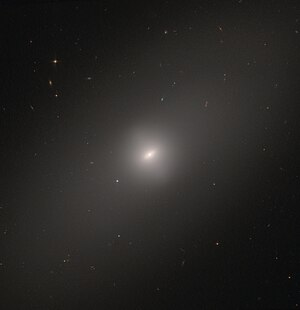NGC 3384
| Galaxie NGC 3384 | |
|---|---|
(c) ESA/Hubble, CC BY 4.0 | |
| NGC 3384, aufgenommen von dem Hubble-Weltraumteleskop | |
| AladinLite | |
| Sternbild | Löwe |
| Position Äquinoktium: J2000.0, Epoche: J2000.0 | |
| Rektaszension | 10h 48m 16,9s[1] |
| Deklination | +12° 37′ 45″[1] |
| Erscheinungsbild | |
| Morphologischer Typ | SB(s)0-:[1] |
| Helligkeit (visuell) | 9,9 mag[2] |
| Helligkeit (B-Band) | 10,9 mag[2] |
| Winkelausdehnung | 5,4′ × 2,7′[2] |
| Positionswinkel | 53°[2] |
| Flächenhelligkeit | 12,9 mag/arcmin²[2] |
| Physikalische Daten | |
| Zugehörigkeit | M96-Gruppe LGG 217[1][3] |
| Rotverschiebung | 0,002348 ± 0,000008[1] |
| Radialgeschwindigkeit | (704 ± 2) km/s[1] |
| Hubbledistanz H0 = 73 km/(s • Mpc) | (37 ± 11) · 106 Lj (11,261 ± 3,243) Mpc [1] |
| Durchmesser | 55.000 Lj |
| Geschichte | |
| Entdeckung | Wilhelm Herschel |
| Entdeckungsdatum | 11. März 1784 |
| Katalogbezeichnungen | |
| NGC 3384 • NGC 3371 • UGC 5911 • PGC 32292 • CGCG 066-021 • MCG +02-28-012 • 2MASX J10481689+1237454 • GC 2207 • H I 18 • h 758 • Holm 212B • PRC C-34 • LDCE 0778 NED010 | |
NGC 3371 = NGC 3384 ist eine Linsenförmige Galaxie vom Hubble-Typ SB0 im Sternbild Löwe auf der Ekliptik. Sie ist schätzungsweise 37 Millionen Lichtjahre von der Milchstraße entfernt.
NGC 3384 findet sich zusammen mit Messier 105 und NGC 3389 im selben Himmelsareal und bilden dort ein optisches Tripel. Während es sich bei NGC 3389 um ein Hintergrundobjekt in etwa doppelter Entfernung handelt, gehören die beiden anderen Galaxien zur 30 bis 35 Millionen Lichtjahre entfernten Leo-Gruppe. Für NGC 3384 wird ein Durchmesser von etwa 55.000 Lichtjahren angenommen.[4]
Das Objekt wurde am 11. März 1784 von Wilhelm Herschel entdeckt. Wahrscheinlich bezieht sich der Katalogeintrag NGC 3371, der auf eine Beobachtung von John Herschel vom 23. März 1830 zurückgeht, ebenfalls auf diese Galaxie.[5]
Literatur
- H. Meusinger, H. A. Ismail: The inner structure of the S0 galaxy NGC 3384. In: Astronomische Nachrichten. Band 328, Nr. 6, 2007, S. 562.
- Busarello u. a.: Yet another sub-component inside a bulge: the structure of the peculiar S0 galaxy NGC 3384. In: Astronomy and Astrophysics. Band 314, 1996, S. 32–42.
- König, Michael & Binnewies, Stefan (2019): Bildatlas der Galaxien: Die Astrophysik hinter den Astrofotografien, Stuttgart: Kosmos, S. 195
Weblinks
- spektrum.de Amateuraufnahmen.
- spektrum.de Umgebungskarte.
- Settling into old age
Einzelnachweise
Auf dieser Seite verwendete Medien
(c) ESA/Hubble, CC BY 4.0
NGC 3384, visible in this image, has many of the features characteristic of so-called elliptical galaxies. Such galaxies glow diffusely, are rounded in shape, display few visible features, and rarely show signs of recent star formation. Instead, they are dominated by old, ageing, and red-hued stars. This stands in contrast to the sprightliness of spiral galaxies such as our home galaxy, the Milky Way, which possess significant populations of young, blue stars in spiral arms swirling around a bright core.
However, NGC 3384 also displays a hint of disc-like structure towards its centre, in the form of a central ‘bar’ of stars cutting through its centre. Many spirals also boast such a bar, the Milky Way included; galactic bars are thought to funnel material through and around a galaxy’s core, helping to maintain and fuel the activities and processes occurring there.
NGC 3384 is located approximately 35 million light-years away in the constellation of Leo (The Lion). This image was taken using the NASA/ESA Hubble Space Telescope’s Advanced Camera for Surveys.
